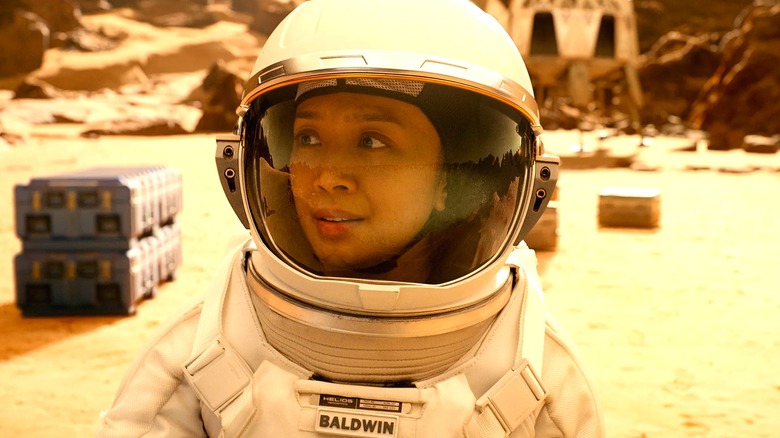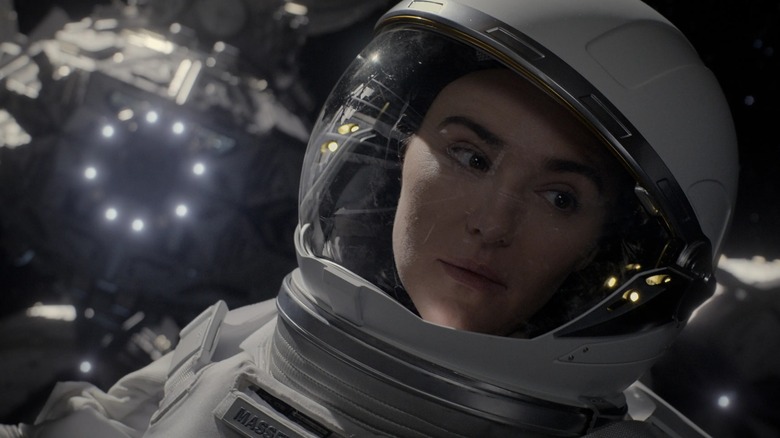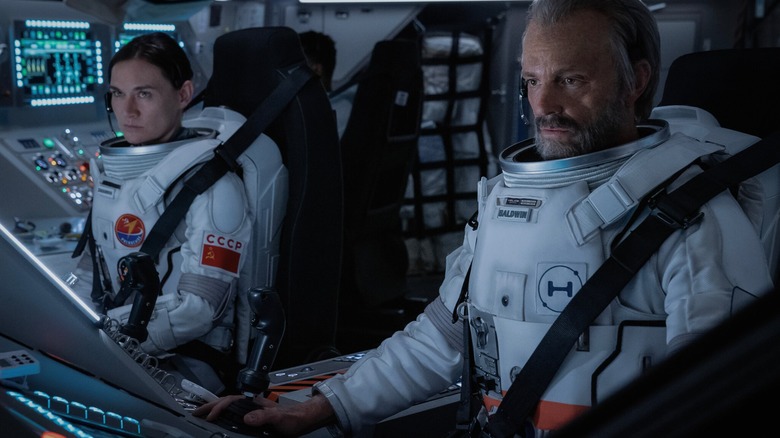This Apple TV+ Sci-Fi Series Gets A NASA Astronaut's Stamp Of Approval For Its Accuracy
This post contains spoilers for "For All Mankind."
After astronauts Neil Armstrong and Buzz Aldrin stepped foot on the Moon as a part of the Apollo 11 mission, a stainless steel commemorative plaque was left on the lunar surface. The inscription on the plaque reads: "Here men from the planet Earth first set foot upon the Moon July 1969, A.D. We came in peace for all mankind." These permanent plaques, which became a staple in subsequent lunar missions (up until Apollo 17), are meant to be expressions of peace and goodwill on behalf of humanity as a whole. But what would happen if history was to be altered, leading to a global space war that never ended? This is the essential question put forward by the Apple TV+ show "For All Mankind," which reimagines the moon landing from an alternate history perspective (one that is explored in vivid detail).
"For All Mankind" takes place in a world where Soviet cosmonaut Alexei Leonov becomes the first person to land on the moon, prompting the rattled folks at NASA to scramble in an effort to catch up. Forced to match and outdo the Russian space program, NASA green lights mission after mission, all the while widening the ambit of competent astronauts eligible for space travel. An astounding domino effect is thus set in motion, impacting everything from major historical events to the "Star Trek" franchise. The scope of the show's imagination is boundless, as NASA figures out a way to establish colonies on the Moon soon after (with plans to move on to Mars next). Meanwhile, the Soviet Union appears to be thriving in the series' parallel timeline thanks to a combination of socio-political factors.
While alternate history fiction is not a novel sub-genre ("The Man in the High Castle" and "Watchmen" are both popular examples), it demands incredible accuracy to be compelling; after all, you can't create a divergent version of history without having an in-depth knowledge of actual events. That being the case, "For All Mankind" showrunner Ronald D. Moore enlisted real-life astronauts as consultants to ensure maximum accuracy throughout the series, including the engineer and former NASA astronaut Garrett Reisman. Let's take a closer look at Reisman's involvement and how accurate the show is in its depiction of an alternate space race, along with its sociopolitical ramifications.
A conversation with an ex-astronaut led to the conception of For All Mankind
During a 2019 interview with Collider, Moore explained that the core idea of the show (that is, an alternative reality where NASA wasn't the first to land on the moon) came from a conversation he had with Reisman. This, in turn, encouraged Moore to further explore how the "butterfly effect moment" would've affected history, including "the impetus for the space race to continue beyond Apollo 17." The showrunner went on to explain the subtle yet essential changes the series made to the real-life fate of Sergei Korolev, the chief designer of the Soviet space program:
"He [Korolev] died and, as a result, the Soviet program was really never the same. The rocket that they had designed for their moon attempt literally never really got off the ground and had explosions. So, our deeper premise, even though it's not really stated in our pilot episode, is that Korolev lives. He survived the surgery and kept the Soviet program together, and was able to solve the design flaws in the rocket. He accelerated the program and had enough juice to keep the whole bureaucracy together and the funding going, and that's when it all changed."
NASA flight director Gerry Griffin was also called in to oversee aspects related to mission control, including the aesthetic accuracy of display panels in space missions. Griffin praised the spectacular mission control center set built for the series, stating that the goal was to remain "extremely realistic" even within the alternate history mold. Reisman also had the following to say about the challenge of trying to get the technical aspects right without compromising the creative integrity of such a promising story:
"What's really fantastic is how much everybody is really passionate about getting the details correct and the technical parts of it correct. At the same time, I've been trying very hard to not let any the truth get in the way of a good story. One of the things I'm very cognizant about is that what's gonna make this show resonate with people is the story and the characters, and not necessarily whether they have the right instrument panel configuration, or whatever."
As it turns out, "For All Mankind" has managed to strike the perfect balance between scientific accuracy and creative liberty, resulting in a show that isn't afraid to take some wild, unexpected swings. (You can read /Film's review of the show's brilliant fourth season here.) Moreover, most of the series' character dynamics arise from their passionate, backbreaking work, yet these professional spaces still feel as rich and complicated as any personal relationships divorced from work-related settings.
For All Mankind's stunningly detailed spacecraft interiors are also faithful to real life
"For All Mankind" employs a mix of archival footage and recreated shots to bring its alternate world to life. Of course, it's quite difficult to recreate spaces that faithfully mirror a bygone era. For example, it's nearly impossible to acquire TV sets that were made in the 1960s (the Apollo era of season 1), as period-accurate CRTs (cathode-ray tubes used in televisions) are a rarity today.
These practical hurdles forced Moore and co. to improvise a bit, like simulating how these CRTs looked and felt during the time. But apart from these minor aspects, most of the things we see on the show are period-accurate, including the Apollo suit replicas used in the interior of spacecraft sequences. However, it is tricky to get everything right and discern what works from a technical standpoint. This is where Reisman's expertise came in handy.
In that same Collider interview, Reisman spoke about the challenges that came with portraying weightlessness inside the spacecraft in season 1, as the show's cast and crew had to keep the laws of physics and the nuances of the indoor set in mind:
"Getting all of the physics right, in all those shots, and getting tethers to not just fall down in one-G, but to simulate like they're floating in zero-G, was really challenging. We were constantly fixing things or changing things to make it better [...] For me, personally, the other thing that was challenging was, I flew in the space shuttle and this first season [of the show] is set in the Apollo era, and it was a real education for me in remembering. Fortunately, a lot of it is very similar. We borrowed heavily from the architecture of Apollo."
It's important to keep in mind that the show is a labor of love made possible due to close-knit collaboration, with expert consultants like Reismer (among many others) working closely with Moore, the writers, and the visual effects and set design teams. The show's later seasons, including the fairly recent season 4, deal with different periods in time, which calls for fresh approaches to the space race concept while altering things enough to convey an alternate timeline. There's no doubt that so long as "For All Mankind" is going, it will continue to expertly balance functional aesthetics and scientific precision while letting us have an extraordinary peek into a world that could have been.
"For All Mankind" is currently streaming on Apple TV+.


